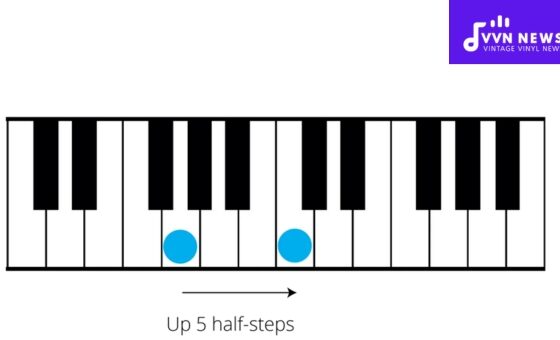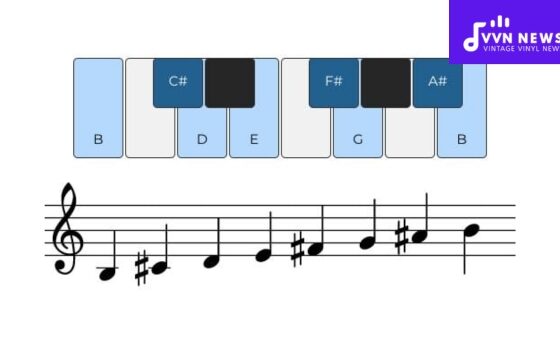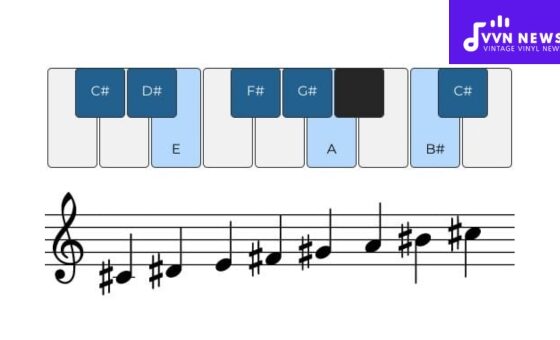We all come across moments when we need or want to delve deeper into the world of music theory.
Whether you’re an aspiring musician wanting to expand your skills or merely a music lover aiming to broaden your comprehension, understanding musical scales and chords can significantly enhance your appreciation for this art form.
In this blog post, we will focus on understanding B Major’s scale and the chords.
Music, in its various forms and genres, has consistently been a medium of expression and communication.
Mastering it, however, requires more than just a love for harmony. It demands dedication and an understanding of its foundations; this involves getting acquainted with musical scales and chords.
One such crucial element forms the bedrock of numerous melodies – the B Major scale.
Combined with its corresponding chords, it offers versatility that has been willingly adopted by composers worldwide.
Now, let’s break it down and comprehend its fundamental aspects piece by piece!
What is the B Major Scale?
The B Major Scale is one of the most essential music scales, consisting of seven distinct notes (B, C#, D#, E, F#, G#, and A#), before returning to the B note at a higher octave.
Characterized by its unique sound that’s often described as bright and joyful, this scale forms the foundation for melodies, harmonies, and musical pieces written in the B Major key.
Observing its pattern of whole and half steps- W-W-H-W-W-W-H – provides insights into composing or improvising music.
Certainly, getting a firm grip on this fundamental scale can significantly contribute to your musical journey.
How to Play the B Major Scale on Different Instruments

With nuanced notes, the spectrum of sound that the B Major scale brings forth echoes succinctly across various instruments.
Let’s explore how you could master this enticing scale on different instruments.
Piano
Playing the B Major scale on the piano requires some practice, owing to its unique composition entailing five sharps. To begin:
- Start on the note B (usually a white key located to the right of A).
- Follow this sequence: white key, black key, black key, white key, black key, black key, black key.
- Understand that each sharp signifies a shift from a white key to its adjacent black one.
- Lay your hands aptly so your thumb (for the right hand) or little finger (for the left hand) lands on every white note.
Guitar
To play this scale on a guitar:
- Situate your index finger’s point of reference as the 7th fret on E string.
- Proceed with this fret pattern: E – 7-9; A – 6-7-9; D – 6-8-9; G – 6-8; B – 7-9; E – 7-9.
- Ensure you accurately pick each corresponding string and maintain a steady rhythm.
Violin
On a violin:
- Position your fingers in an ascending order starting from open B string to A#.
- Incorporate varying fingerings for diverse tonal flavors.
- Keep in mind that precision is needed to maintain the notes’ accuracy and intonation.
With diligent effort over these steps, you will be adept at performing this bracing scale across multiple instruments representing diverse musical capabilities.
Practice is the linchpin of proficiency in music. As challenging as it can appear initially, with focussed practice sessions, maneuvering through these notes will soon turn into second nature.
Listen to recordings of professional musicians playing these scales on your chosen instrument, providing auditory cues to guide you through mastering these steps.
The Key Signature of B Major
The key signature of B Major identifies the notes that make up this particular scale.
It helps establish the ‘mood’ for the melody, indicating which notes are played as sharps (#) and which ones are natural.
Making use of five sharps in its formation, B Major is composed of the following notes – B, C#, D#, E, F#, G#, and A#.
This sequence designates B as the keynote or the home pitch – and is where the scale starts and ends.
In written music notation like sheet music, you’ll typically notice these sharps at the beginning, right after the clef sign on your staff.
Each sharp corresponds to a specific line or space representing a note on your musical staff.
Specifically for B Major, you will spot sharps on F, C, G, D, and A-lines or spaces.
By recognizing these key signatures, navigating sheet music becomes significantly smoother for musicians across all levels.
Also Read: F Sharp Minor Pentatonic Scale [How To Use In Your Compositions]
Chords within the B Major Scale
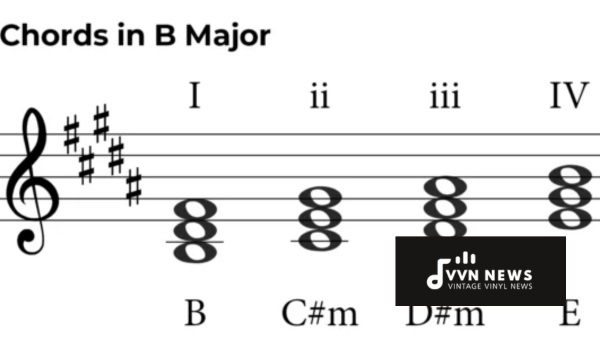
In every major scale, specific chords correspond to each degree of the scale.
In a B Major scale, these are formulated following a specific rule, with each chord giving a distinct sound that impacts how it resonates with the key when played.
- B Major (I): Composed of notes B – D# – F#, this is often recognized as the ‘home’ or tonic chord.
- C# Minor (ii): This chord utilizes notes C# – E – G#, providing a sad sound.
- D# Minor (iii): Consisting of notes D# – F# – A#, its dark tone contrasts with other chords within this scale.
- E Major (IV): With E – G# – B, this vibrant chord often signals a return to the home chord.
- F# Major (V): Comprising F# – A# – C#, it adds a tension that seeks resolution.
- G# minor (vi): Created with G# – B – D#, extends a soothing touch amidst the surrounding excitability.
- A Augmented (vii°): Includes A#- C#+-E establishing an offbeat charm.
Each chord has its flavor and greatly influences how your melody feels or swings!
How do you construct chords in the B major key?
Building chords in the B Major key is not as daunting as it sounds. It requires knowledge of the notes in the B Major scale and some basic music theory, mainly chord theory.
Steps for Building Chords:
- Recognize the B Major Scale Notes: The B Major scale comprises seven unique notes: B, C#, D#, E, F#, G#, and A# (Bold notes indicate the root, third, and fifth notes for the B major chord).
- Determine Every Chord’s Root Note: When creating a chord, each one will have a different root note. The root note for each chord aligns with each individual note of the major scale.
- Build the Chords: Once you know your root notes, create each chord by adding every other note from the scale above it until you have a triad (three unique notes). For example, taking ‘B’ as our first root note, we can make our first chord by including ‘D#’ (the 3rd) and ‘F#’ (the 5th). This gives us our first chord, “B.”
Taking this approach through all seven notes will give you a harmonious progression through all chords within the key of B major.
Knowing how to build chords is an essential skill for writing your music or improvisation.
With this in-depth exploration of chords within the B Major key, I hope you feel better equipped to navigate and innovate your unique melodies. So please take out your instrument, and let’s make some great music.
Also Read: G Sharp Minor Pentatonic Scale [Add Dimension To Your Music]
Describing the B Major Scale In Different Clefs
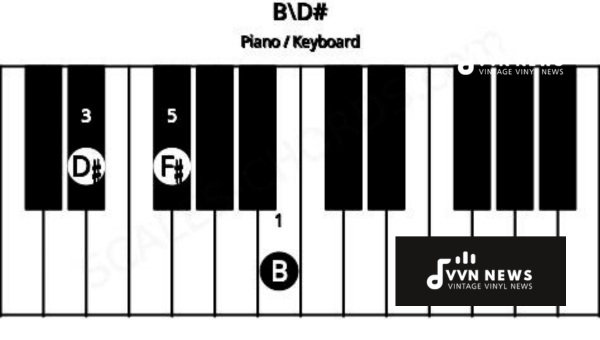
Transcription of music into different clefs makes music accessible to a variety of instruments.
Let’s delve into how the B Major scale appears in several common clefs – the Treble, Bass, Alto, and Tenor.
Treble Clef in B Major
The Treble Clef, often used in music for higher-pitched instruments and voices such as flutes, violins, and sopranos-the B Major scale begins on the middle line.
Entailing notes from B to B’, the ascending and descending structure looks like this- B C# D# E F# G# A# B’.
The key signature for Treble Clef consists of five sharps (F#, C#, G#, D#, A#), marked at the beginning of every line within this scale.
Bass Clef in B Major
Next comes the Bass Clef, primarily applied for lower-pitched instruments, including cello or tuba. In Bass Clef, Key B is represented on the third line from the top within a staff.
The note series mirrors that of Treble clef- starting from middle-B going till high-B’. Again, five sharp symbols are positioned as key indicators before each stave.
Alto Clef in B Major
The often-less-seen Alto Clef mostly finds use among violas and trombones.
In this clef’s context, our center is on the fourth line from the bottom, nearly halfway between bass and treble clefs on grand staff- retaining the same span from middle-B till high-B’.
As earlier described schemes, five sharps lead each stave for this unique clef, too.
Tenor Clef in B Major
Finally arrives Tenor Clef, primarily chosen for upper ranges on bassoons, cellos, trombones, and bass clarinets.
It has B on the fifth line from the top, covering an identical note range from B to B’.
Invariable to other clefs, five sharps mark endpoints before introducing each new stave.
Notably, even though key placements vary across different clefs, the adoption of the five-sharp key signature remains consistent across all to depict B Major.
This variety in notations contributes to music’s universality- enabling players to decipher pitches depending on their instruments’ ranges.
Common Progressions in B Major
When it comes to establishing rhythm and harmony in music compositions, chord progressions play a pivotal role.
These are specific sequences of chords in a specified key that provide your music with recognizable direction and movement.
Like other keys, the B Major scale has some common chord progressions that we frequently experience across different genres of music.
V-I (F# – B) Chord Progression
Firstly, let’s discuss one of the most recognized progressions in Western music – V-I (pronounced as five-one).
In the key of B Major, this progression would be F#-B. Known equivalently as ‘the perfect cadence’, this sequence yields a feeling of resolution and finality.
It’s a common ending progression for various songs as it conveys a strong sense of ‘home’, returning to the tonal center of B.
II-V-I (C#m7 – F# – B) Chord Progression
Another recurring progression comprises three chords and is called the II-V-I (two-five-one), which translates into C#min7-F#-B in the key we’re discussing.
This chord sequence is particularly prevalent in jazz but is also widely used across pop, blues, rock, and classical music.
The smoothness in transition between these chords generates peculiar melodic lines that musicians often appreciate.
I-IV-V (B – E – F#) Chord Progression
Also worth noting is I-IV-V (one-four-five), which in simple terms means B-E-F#.
This progression forms the foundation for countless pop songs and frequently dominates blues and rock genres.
These are just commonplace progressions featuring our hero today – the B Major scale.
To further experiment or make diverse tunes out of these combinations or others not mentioned here, practice remains your best friend.
Also Read: How To Structure The First Flute Lesson? [Expert Advice]
How Does B Major Compare to Other Major Scales?

The B Major scale encompasses specificity in tone, unlike features of other major scales.
It posed unique characteristics, reflecting its distinct flavor and color in music composition.
Comparison Based on Tonal Quality
Every scale has a distinctive sound, feeling, or aesthetic quality. In comparison to the light and bright nature of C Major or the solemn temperament of D Major, B Major emits a triumphant yet soothing resonance. This unique tonal quality sets it apart from its counterparts.
Note Placement and Ease of Use on Instruments
Comparing usability on various instruments makes B Major quite contrasting.
On the piano, B Major stands as one of the more complex scales due to having five sharp notes: F#, C#, G#, D#, and A#.
On the other hand, scales such as C Major are simpler with no sharps or flats. This factor favors guitar players, though, because chord transitions are smoother due to barre chord positioning favoring ‘sharp’ keys.
Pitch and Progression
From a pitch perspective, B Major’s leading tone (A#) progresses well into the tonic note (B), creating a solid resolution lacking in some other major scales.
Consequently, tunes ending on this pitch deliver satisfaction, attaining musical resolution.
The impact of harmonic progression between respective chords within each key results differently, too; some produce intense emotions while others might be subtle or neutral – that’s where B Major shines with its balanced temperament.
Songs in B Major
Over the years, we’ve seen a plethora of popular tracks use the B Major scale to create beautiful and memorable melodies.
Here are five songs that shine through with B Major’s distinctive texture:
1. “Yellow” by Coldplay
Nothing played in B Major comes close to the international smash hit, “Yellow” by _Coldplay.
This song employs an innovative tuning (E-A-B-G#-B-E) that further enhances its musical charm.
The rhythm guitar from Jonny Buckland, coupled with Chris Martin’s vocals, shows the versatility and richness of the B major scale.
2. “Lovely” by Billie Eilish & Khalid
The enchanting song “Lovely,” by Billie Eilish and Khalid, contains motifs and progressions, creating a haunting sound overlap.
The melody traces its deep roots to the versatile B Major Scale. The layering of strings over Billie’s ethereal voice coated with Khalid’s soulful singing offers a sublime auditory experience.
3. “Just What I Needed” by The Cars
Ric Ocasek wrote “Just What I Needed” for the band The Cars.
It is a power-pop staple using the B Major chord prominently in its captivating hooks, displaying how effortlessly cool this key can be.
4. “Lucy in the Sky With Diamonds” by The Beatles
Imagine a psychedelic journey with Lennon-McCartney’s masterpiece, “Lucy in the Sky With Diamonds” from The Beatles.
This song takes turns oscillating between A Major and B Major chords, taking full advantage of the latter’s brilliant sound palette.
5. “January Rain” by David Gray
Soft rock fans will recognize David Gray’s “January Rain” from the cult classic film Serendipity.
The song provides a stark representation of the melancholy that can be expressed within the B Major scale.
These are just a few notable examples in music history that have successfully married lyrics with the hues of B Major.
They prove how this musical scale’s versatile nature offers countless opportunities for musicians to express their emotions and ideas.
Also Read: What Is A Headphone Amplifier? [Why You Need It In 2025]
FAQs About the B Major scale
What notes are in the B Major scale?
The B Major scale is made up of the notes – B, C#, D#, E, F#, G#, and A#.
Can I use the B Major in any type of music genre?
Absolutely! The beauty of scales like the B Major lies in their versatility. They can be incorporated into numerous genres, from rock to classical compositions.
Are there any particular moods or feelings associated with the B Major key?
Music analysts often associate the B Major key with a bright and positive mood. It’s commonly found in uplifting and joyful musical pieces.
Is it challenging to learn to play in B Major as opposed to other keys?
While it might initially pose a challenge because of its five sharps, practice will soon smoothen your journey in mastering it just like any other scale.
How can understanding the B Major scale affect my performance?
Understanding scales allows you to understand chord progressions better, improvise during performances, and aid in comprehending sheet music more easily.
Conclusion
Grasping the B Major scale and its accompanying chords provides a deeper understanding of aural aesthetics, undoubtedly boosting your musicianship skills.
By laying stress on the practical applications of this knowledge — from identifying the B Major scale on different instruments to implementing it in chord progressions — you can experiment with a more intricate level of creativeness.
Learning may seem daunting initially, but remember, perseverance is what molds an amateur into a professional!
So, whether you’re an aspiring artist or a dedicated music lover, ride the wave of musical theory and uncover new horizons in your journey!

